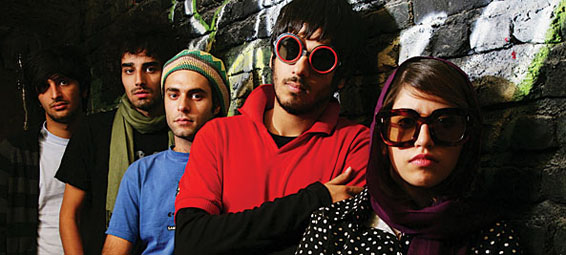I’ve now seen two recent movies from Iran that reveal a new boldness in the cinema being made there, and a desire to show the life of the youthful underground in that country. The first was Granaz Moussavi’s My Tehran For Sale, which screened at this year’s Dallas International Film Festival, and tackled such taboo subjects as HIV, immigration, and artistic freedom in totalitarian Iran. The second is No One Knows About Persian Cats, which is currently playing at the Angelika Film Center. There is a similarity of style between these two films. Both are unpolished, low budget affairs that were made semi-covertly on the streets of Tehran. Both also deal with the lives of artists. My Tehran for Sale follows an underground theater actor, while No One Knows About Persian Cats pulls back the official veil to reveal Tehran’s underground rock scene.
No One Knows About Persian Cats follows two young indie rockers, Negar (Negar Shaghaghi) and Ashkan (Ashkan Koshanejad), who are trying to form a band and travel to a show in London, England in which they have been invited to participate. That search takes them through the local music scene, meeting members of bands that range from punk and heavy metal to blues and traditional Iranian style. It also runs them up against the day-to-day legal difficulties of life in Iran: obtaining illegal passports and visas, sneaking band practices in hidden rehearsal spaces, recording in underground studios, performing at secret parties, and dealing with police who confiscate and deal out lashes for possessing foreign movies and music albums. In many ways, the main plot of the film feels like an excuse to get into what director Ghobadi seems primarily concerned with: the breadth and quality of Iranian pop. When we encounter new bands, the film often breaks away and takes the form of a music video, scattering street shots and fast cuts of the people and architecture of Tehran to the soundtrack of the various bands. In any western film, the effect might feel forced and cheesy, but in Persian Cats, Ghobadi is accomplishing something subtle and profound with his mini videos – he makes illegal music the soundtrack to Iranian life and shows that its rhythm and melodies both resonate with and reveals an aspect of the local soul of the people. This isn’t foreign music that should be banned; it is Tehranian Blues.
When most American audiences think of Iranian cinema, it is likely the exquisite work of director Majid Majidi (The Color of Paradise, Children of Heaven). His work is widely-known in part because his elegant, pious style runs fiction under the noses of Iranian censors. While Nobody Knows About Persian Cats doesn’t compare to Majidi’s work on a poetic level, it is interesting to contrast their approach to truth-telling within the context of a totalitarian regime. Majidi opts for fable and the universality of the longings of the human heart. Ghobadi shows that artistic product– in this case, the music – is undeniably part of the Iranian heart, censored or not.





